Everything you need to know about peach grafting

Peach grafting, like any other fruit crop, with a responsible and comprehensive approach to business, gives unique seedlings from which you can get several different varieties. For example, if you like peaches with easily separating pits, then you can try all the varieties that have this property.
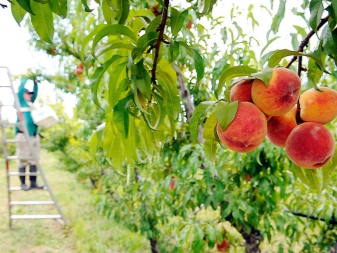
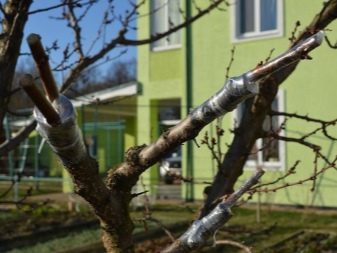
Timing of the procedure
In the Crimea, as well as in the south of Russia, where grafting is done on almonds, the graft is carried out in early or mid-March. In the middle lane, including the Moscow region, it may be the end of March or the beginning of April - it is important that the night frosts stop. In the Urals, this is the beginning, middle or end of April, the winters are severe there.
When the winter turned out to be abnormally frosty, the grafting time was postponed a month closer to summer.
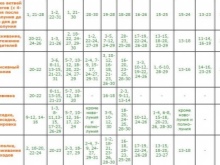
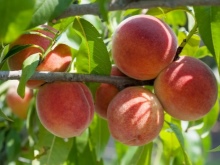
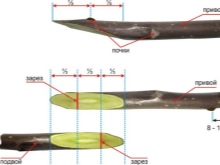
What can you vaccinate on?
Wild apricot grown from stone has good drought and frost resistance. This method is suitable for beginners. Plum and some varieties of cherries are also considered frost-resistant: they are not afraid of temperatures not lower than -25. Probably the best rootstock is a peach with a hard-to-remove bone - any variety whose fruit is difficult to eat. A variety with an easily separable stone, grafted onto a hard-to-remove peach, results in a sweet and high quality fruit. As such a tree grows, the amount of peach harvest increases each year.
The resulting tree does not have a tendency to form basal (daughter) processes. Those, in turn, do not have the property of a grafted tree and form thickets of wild, which must be cut down in time so that they do not take away nutrients from the main tree. Peach grafting on peach does not give resistance to frost and drought - it is recommended to plant it in a place protected from the wind, in a well-sunlit area. The minimum period after which the harvest will be stable and abundant is three years, but on average at least 6 years should pass.
Grafting a peach on a cherry plum or felt cherry will give resistance to diseases, and the taste of such a peach will be the most pronounced. But cherry plum itself gives abundant root shoots, which must be constantly cut down. The early varieties of peach, as well as the "Kiev" variety, are distinguished in this case by a good return. It is possible to graft a peach on an almond tree - it grows large, up to 7 meters. Zoned - adapted to local climatic conditions - varieties can be purchased at the nursery. Grafting on an apple tree will give the best result when the rootstock (main stem) is a two-year-old seedling grown in the garden in a separate place from an apple seed.

Preparation
The rootstock is any of the trees listed above. It must be no more than two years old, and the trunk diameter does not exceed a centimeter. The grafting blanks are prepared in the fall, before the onset of the first frost. This mainly happens due to freezing in the winter of some of the annual shoots, and in March it will not be possible to distinguish by eye which of them are viable. Grafting frozen in winter will practically not give any positive outcome. The branches you like are cut off, and from them, in turn, an average segment of no more than 15 cm is cut out. This shoot should not be less than 5 mm in diameter - it is too thin, although lignified is not viable. The stalk must contain at least 10 buds.The cuttings are sealed in a bag and placed in the refrigerator (but not in the freezer). The storage temperature is approximately +1. When the grafting time comes, it is placed in water for a couple of days, so that it “comes to its senses”.
The scion work is carried out using a sterilized and pre-sharpened (like a clerical knife) secateurs. Stronger branches may require a hacksaw for metal with very small teeth: the main thing is not to wrinkle the saw cut. As additional consumables - electrical tape, PVC film, medical bandage, paper and garden var. Newsprint is ideal for covering the scion from the sun's rays - the spring sun is noticeably more active than the winter one.
As a pruner, a variety of it is suitable, which is just designed for grafting: the cuts can be made as accurate as possible.
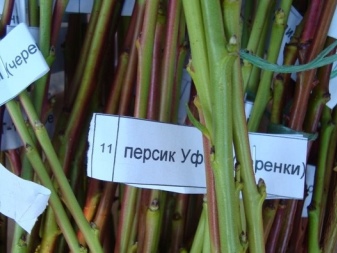
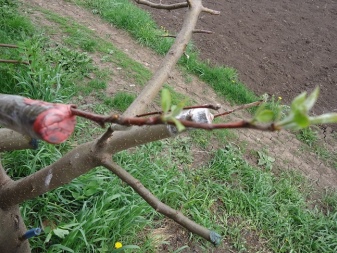
Methods
There are no restrictions, prohibitions on the use of any method. If you are sure that you will do everything right, then use any of the vending ones. But for beginners, a more simplified option is suitable, chosen by each garden owner independently. If you are not fluent in the grafting procedure, practice on pruning, for example, after the formation of the crown, rejuvenation of the old tree. Simplified step-by-step instructions for planting a scion on a stock is as follows:
- prepare the scion and stock for combination;
- insert the scion into the stock;
- the scion and rootstock are wrapped with electrical tape or a washcloth, and then covered with wax or garden varnish.
If the grafting was successful, then after 21 days the rootstock grows together with the scion. Different methods do differ.
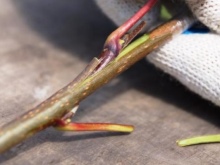
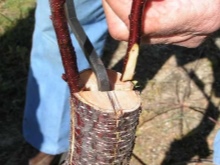
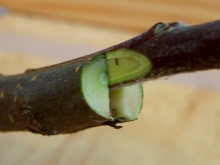
Copulation
There are conventional and improved methods, united by the general term - copulation. Peach grafting is carried out only in spring, until the tree "wakes up" and the sap flow is still in place. It is necessary to prepare in advance a section of a branch that matches the diameter of the stock. In extreme cases, the stock may turn out to be somewhat thicker than the scion stalk, and you will have to combine the cambium of both.
- A beveled incision is made on the stock trunk.
- The same thing is done under the lowermost kidney. Both cuts must match the length and angle of the notch.
- After preparation, they are combined and tied tightly, with some effort. Do not overdo it, so as not to transfer layers that will grow together.
- The upper part of the scion is shortened. The number of free buds located from the place where the rootstock and scion are combined is at least 3.
- The upper cut is covered with garden varnish or paraffin.
Advanced copulation starts with slices:
- a third of the length is measured from the cut both on the rootstock, and on the scion shoot, tongues are cut a centimeter deep, which are inserted into each other;
- the grafting site is tied, covered with garden pitch;
- cut off all the kidneys above the third (from the grafting site);
- the upper circumcision site is also sealed with pitch or paraffin.
The bud is grafted - you just have to wait until it grows to the tree.
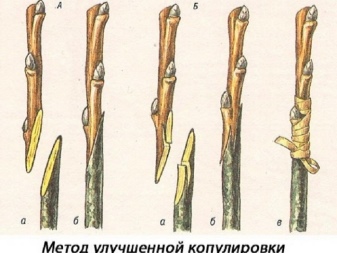
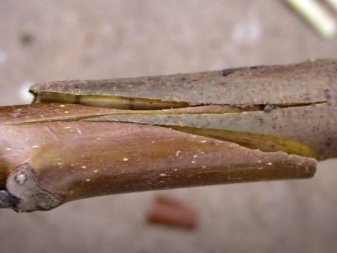
Budding
Inoculation is based on peephole grafting. The deadline for execution is the end of July or the beginning of August. Further growth of shoots is suspended, while the buds on them are considered mature. Do not rush with the timing of budding: early grafting in this way will lead to the fact that the ocelli will germinate in the fall, and with the onset of frost they will freeze. Likewise, one should not be late in time: the buds will not have enough days to finally grow to the stock, since the cambium, due to which the scion grows to the tree trunk, will not have time to release the required amount of juice and produce new cells of bast and wood. Budding in terms of tree fruiting is considered the best way: yields are subsequently harvested more than decent, and the resulting tree does not suffer from any diseases.
To form a new seedling, budding is carried out in the butt.
- At an angle of 45 °, the bark is cut no further than 3 mm. It will look like a tongue.
- At a distance of 3 cm upwards, a cut of the bark is made with the capture of a small layer of wood.
- A well-developed bud 3 cm long is cut - also with the thinnest layer of wood.
- This kidney is inserted into an incision in the bark by pulling the lower part by the uvula.
- The grafting is tied. After the growth of the shoot from the bud, the winding is unwound from the scion.
In springtime - in the absence of frost - the bud is grafted with a T-shaped incision into the crown of the scion:
- horizontal-vertical pruning is performed on the stock;
- a kidney is cut from the cutting blank - along with the base;
- the kidney is inserted into the incision;
- if the upper edge comes out of the cut, it is cut off with a clerical knife;
- the bottom cut is inserted under the base of the pocket.
The bandage is carried out in such a way that the kidney remains free from the bandage.
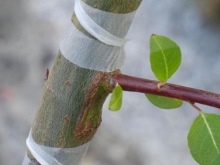


Into the cleft and behind the bark
The likelihood of survival when grafted into the cleft is high. Wait for the kidneys to swell. The trunk at the grafting site is washed from dirt and layers of old bark are removed. The depth of the incision is no more than 3 cm.
- To prevent closure, a wooden wedge is inserted into the resulting split.
- A wedge-shaped cut is made on the scion branch, its length is on average 4 cm. Do not touch the cut with your fingers.
- The graft stalk is stuck into the cleft to close the cambium layers together.
- The grafted shoot is twisted so that it does not slip out, with a film, and the place of the incision is covered with pitch.
- So that the moisture does not evaporate and the stalk does not die, wrap the grafted place with a film or bag.
Grafting for the bark is carried out at the beginning of sap flow, blossoming foliage, and the appearance of inflorescences. Use shoots with not yet "awakened" buds.
- An incision in the bark is made horizontally, from which the bark is cut downwards by an average of 6 cm.
- A bud is removed from the scion, the bark is folded back on the stock material.
- Having inserted the bud into the incision, press it with the rootstock bark so that the scion bark is closed. After tying, the bud should be open - an escape will soon develop from it.
- After three weeks, the harness is removed: if the bud has not fallen off, then the fusion of the scion with the stock was successful.
Shoots growing from branches grafted in this way can break off under their own weight - props will be required here.
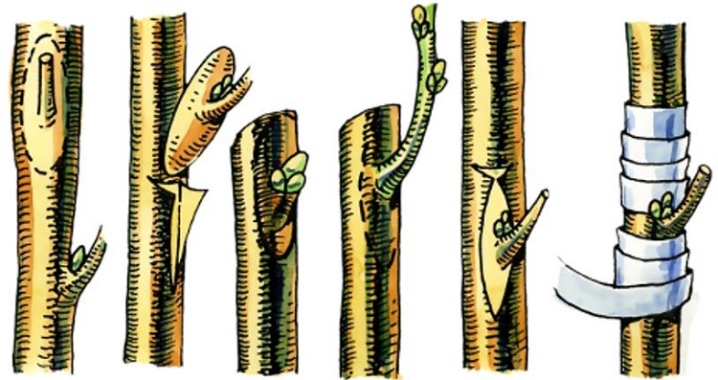
Side cut
This method is relevant in mid-April or early May with active sap flow. The bud should be dormant - it is selected on a cuttings cut in early or mid-March, when the tree has not yet "woken up". The method is suitable for domesticating wild animals around that have grown, but it is not possible to uproot them all. The cuttings are grafted from the lateral part of the stock by sticking their ends into a small incision.
- Make a side cut on the trunk at a 22 ° angle to cut through the bark and some of the wood.
- Sharpen the wedge at the bottom of the cutting so that the cut is oblique on both sides. The depth of the cut and cut are equal, otherwise, being not fully inserted, the scion will not grow together with the stock.
- Insert the handle. Kambia on the scion and rootstock must match.
Cover the upper cut of the cutting - after the third bud - with a garden pitch.

By the bridge
This method is used when the tree has been spoiled, for example, by field and house mice. The disadvantage is that if the bites are not annular, then it is impractical to use it. In other situations, the bite sites are processed using a garden varnish. Grafting with a bridge allows trees to restore sap flow. The scheme of actions is as follows:
- the entire diseased cortex is removed from the damaged area;
- the healthy area is washed and wiped, then cuts are made 3-4 cm under the bark;
- remove buds from cuttings;
- both ends of the cutting are cut along an oblique line - it is recommended to cut the length of the cut by 4 cm;
- peeling back the bark, cuttings are inserted into the cuts;
- tie the grafting sites;
- all open areas are covered with garden pitch.
If all actions are correct, then the scion will take root, and the tree will take on an updated look.
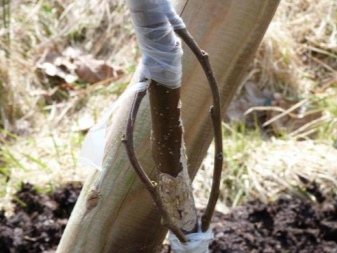

Follow-up care
Each seedling needs timely watering. The main thing is that the soil does not swamp - many fruit crops simply die in the flooded soil, from which air is displaced (the roots rot). Cut off all the growth - it prevents the tree from growing, taking on the necessary crown shape. Regularly inspect the peach tree for the presence of pests - in the fight against them, folk remedies and industrial disinfectants and exterminators are used that do not damage the trees themselves. Spraying or fumigating a tree is carried out in the morning and in the evening, in dry weather: the rain will wash away these funds, and they will fall into the ground, and from there - through the trees themselves into the crop.
Ideally, when the tree is in the shade of other trees or in a greenhouse, the covering layer of which is made of white agrofibre, which allows rainfall and diffused sunlight to pass through. Direct sunlight will dry out the graft site, and the result will be zero.
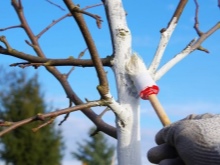
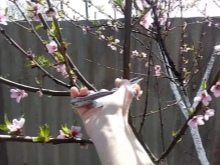
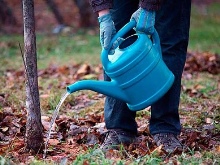











The comment was sent successfully.